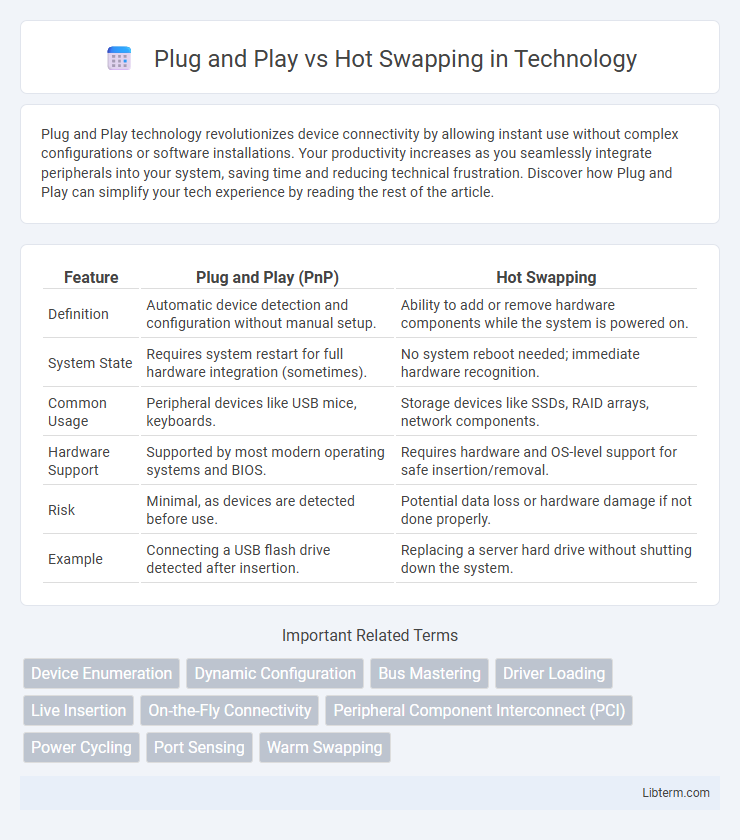Plug and Play technology revolutionizes device connectivity by allowing instant use without complex configurations or software installations. Your productivity increases as you seamlessly integrate peripherals into your system, saving time and reducing technical frustration. Discover how Plug and Play can simplify your tech experience by reading the rest of the article.
Table of Comparison
| Feature | Plug and Play (PnP) | Hot Swapping |
|---|---|---|
| Definition | Automatic device detection and configuration without manual setup. | Ability to add or remove hardware components while the system is powered on. |
| System State | Requires system restart for full hardware integration (sometimes). | No system reboot needed; immediate hardware recognition. |
| Common Usage | Peripheral devices like USB mice, keyboards. | Storage devices like SSDs, RAID arrays, network components. |
| Hardware Support | Supported by most modern operating systems and BIOS. | Requires hardware and OS-level support for safe insertion/removal. |
| Risk | Minimal, as devices are detected before use. | Potential data loss or hardware damage if not done properly. |
| Example | Connecting a USB flash drive detected after insertion. | Replacing a server hard drive without shutting down the system. |
Introduction to Plug and Play and Hot Swapping
Plug and Play (PnP) technology enables computers to automatically detect and configure hardware devices without requiring manual driver installation or system reboot. Hot Swapping refers to the ability to replace or add components such as hard drives, USB devices, or network cards while the system remains powered on and operational. Both technologies enhance system flexibility and minimize downtime in computing environments.
Defining Plug and Play Technology
Plug and Play technology simplifies hardware installation by automatically detecting and configuring devices without requiring manual driver installation or system reboot. It enables immediate device recognition and seamless integration, enhancing user experience and reducing setup time. Plug and Play contrasts with hot swapping, which specifically refers to the ability to add or remove hardware components without shutting down the system.
Understanding Hot Swapping Functionality
Hot swapping enables the removal or insertion of hardware components without shutting down a system, ensuring continuous operation and minimizing downtime. This functionality depends on compatible hardware and software that support dynamic configuration and real-time resource management. Unlike plug and play, which primarily focuses on automatic device recognition during startup or connection, hot swapping emphasizes seamless, uninterrupted hardware changes during active use.
Key Differences Between Plug and Play and Hot Swapping
Plug and Play (PnP) refers to the automatic recognition and configuration of hardware devices by an operating system upon connection, allowing immediate use without manual setup. Hot Swapping enables the removal or replacement of hardware components from a system while it remains powered on and operational, minimizing downtime during maintenance or upgrades. The key differences lie in PnP's focus on seamless device detection and configuration versus Hot Swapping's ability to physically interchange hardware without shutting down the system.
Common Use Cases for Plug and Play Devices
Plug and Play devices are commonly used in scenarios such as connecting USB peripherals like keyboards, mice, and external storage drives, allowing instant recognition and functionality without manual driver installation. They are essential in consumer electronics, where users frequently add or remove devices like printers, cameras, and audio interfaces for seamless integration. This technology enhances user experience in office environments and personal computing by minimizing setup time and technical complexity.
Typical Applications of Hot Swappable Components
Hot swappable components are essential in data centers, allowing servers and storage devices to be replaced without shutting down systems, ensuring continuous operation and minimizing downtime. Enterprise RAID arrays and network switches utilize hot swapping to maintain network stability and data integrity during component failures or upgrades. Industrial automation systems also benefit from hot swappable modules, enabling on-the-fly maintenance and enhancing system reliability in critical manufacturing processes.
Advantages of Plug and Play Systems
Plug and Play systems streamline device installation by automatically detecting and configuring hardware without requiring manual driver installation, significantly reducing setup time and user errors. These systems enhance compatibility across diverse devices and operating systems, ensuring seamless integration and improved user experience. The automatic recognition and configuration capabilities of Plug and Play optimize system efficiency and enable immediate use of peripherals upon connection.
Benefits of Hot Swapping Capabilities
Hot swapping enables seamless replacement or addition of hardware components without powering down the system, minimizing downtime and enhancing productivity in critical environments such as data centers. This capability supports continuous operation and immediate troubleshooting, which is essential for maintaining service availability in enterprise-level applications. Hot swapping also reduces the risk of data loss or hardware damage associated with power cycling, making it a preferred choice for high-reliability systems.
Potential Limitations and Challenges
Plug and Play devices may face compatibility issues due to outdated drivers or hardware constraints, limiting seamless integration. Hot swapping can lead to data corruption or hardware damage if not properly supported by the system's firmware and operating system. Both technologies require robust error handling mechanisms to prevent system instability during device insertion or removal.
Future Trends in Device Connectivity
Plug and Play technology enables automatic device recognition and configuration, significantly simplifying connectivity and user interaction, while Hot Swapping allows devices to be replaced or added without shutting down the system, enhancing operational flexibility. Future trends in device connectivity emphasize seamless interoperability, increased reliance on AI for predictive device management, and the integration of edge computing to process data locally for reduced latency. Advancements in universal standards such as USB4 and Thunderbolt 4 will drive faster data transfer rates and power delivery, supporting a more robust and dynamic ecosystem for both Plug and Play and Hot Swapping capabilities.
Plug and Play Infographic

 libterm.com
libterm.com